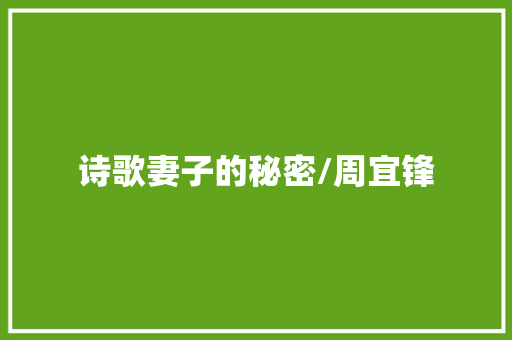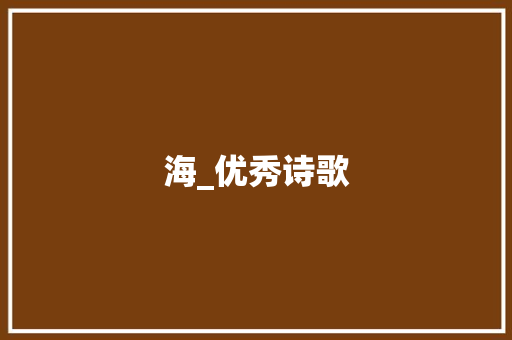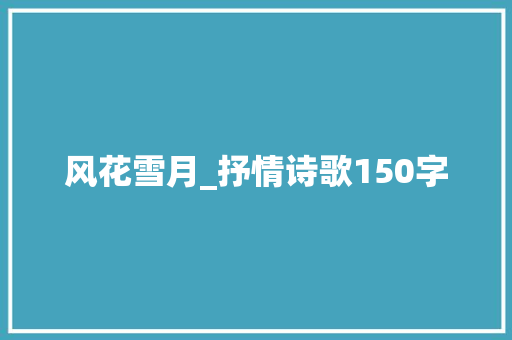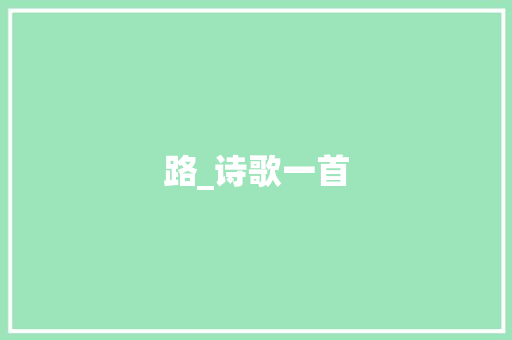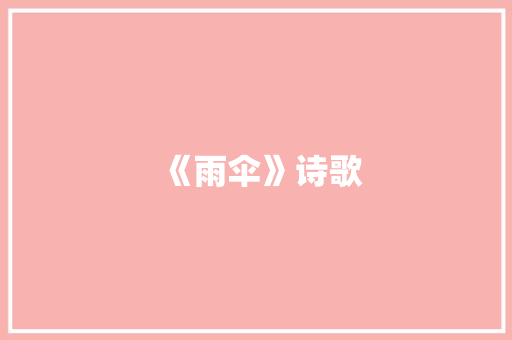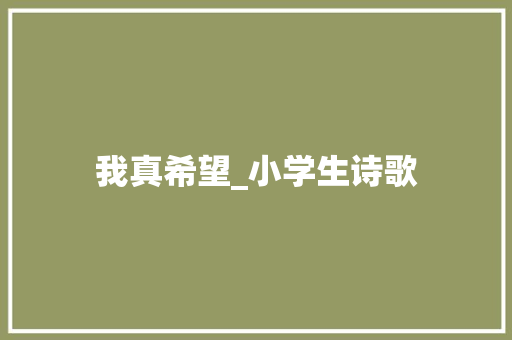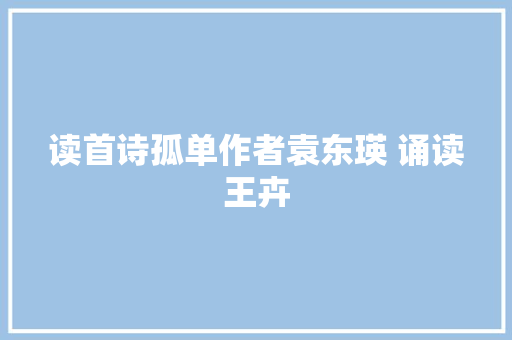本辑五首诗仅由两位作者——温馨和薄暮——创作。诗歌共同关注点是严厉的工业作业环境。读者会发觉自己置身于工厂、采石场和钢铁厂,反思工业活动与自然之间的关系。五首诗中第一首是温馨的《采场上,制作一个踏板》。这首诗中,我们看到自然界风吹草动和满树繁花与人工焊接过程形成强烈比拟。然而,金属经由加工后,形态更具魅力、更为实用:“抬槽钢,割钢筋,弯一个俊秀的弧度”。焊接过程也可以是创造美的过程。诗篇读罢,读者会感想熏染到天下是由两个相辅相成的部分组成—自然天生和人为创造:
举起右手,焊把及焊把线
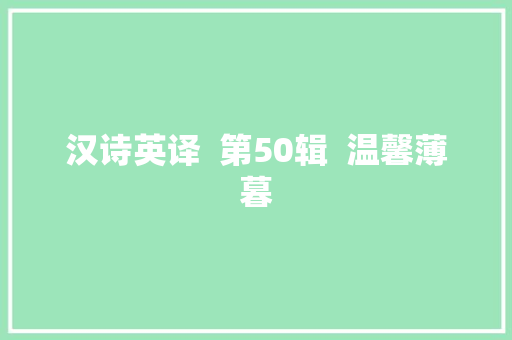
是我新栽的一棵树,全体下午
我都仰望着:一树繁花
第二首是温馨的《冬天,采场上的矿石》,同样以采石场为背景,再次让读者感想熏染到自然与人类天下的延续。草与乌鸦在寒风中一起抖动。诗中人亦置身同样环境,就如采场中的碎矿一样平常。诗作刻画了一位僧人在世事变幻和风雨变革中冥想的形象:
那些碎石子
便是盘坐在矿山的苦行僧,是我内心的流淌小溪
除尘或净心,为我
温馨所作第三首诗是《厂房里的向日葵》。在 “铁与石”的环境中,诗中人手上“沾满油污、泥尘”,而向日葵依旧不染尘埃,通报着乐不雅观向上的感情。花朵干净纯洁,生生不息。年年花复开,是对未来幸福安康的美好希冀。诗中人与向日葵产生共鸣,有息息相通之感:
而我与它的和弦,便是努力追着太阳
把残酷拉长,增重
第四首诗中,我们遇见第二位墨客,薄暮。诗作名为《钢铁厂的风从来不会沉着》,亦将自然与工业过程融为一体。钢铁厂的高温匆匆赌气流涌动。新待出炉的金属犹如“果实正走向成熟”,让读者感想熏染到自然和人造彷佛由此领悟交织。诗篇末端,读者看到钢铁生出 “更长翅膀”,它冲破岩石和泥土的桎梏,迎来新的命运:
风在期待
等它们带着全天下的重量回家
从赤金炉火中生出更长翅膀
本辑五首诗作末了一首是薄暮的《炼轧车间门口看到一只刺猬》。这只弱小薄弱的动物与昼夜运转的炼轧厂机器那震天动地的力量和轰鸣声形成强烈比拟。墨客不敢触碰刺猬,害怕自己会一欠妥心侵害到它。大概刺猬眼中的人类就如曾经人类眼中的轧机,是刺激又可怖的存在:
第一次看到一字排开十台轧机
险些要击穿大地
我屏住呼吸,像一块铸锭
走向钢材,迫切、亢奋、战栗
彼得·休斯 2024年4月 于意大利翁布里亚 采场上,制作一个踏板 温馨 沟渠,又深又窄 风,几次再三地穿过沟底 抬槽钢,割钢筋,弯一个俊秀的弧度 翻动沟渠里的砾石,去掉一株草 一片叶的罗曼史 可以焊接了 同事说,温馨,下到壕沟里去 沟里,只有工具和我自己 石头、泥土是有锋芒的 站、坐、蹲、跪,都弗成的话 躺下,便是坦途 举起右手,焊把及焊把线 是我新栽的一棵树,全体下午 我都仰望着:一树繁花 Welding in the Quarry by Wen Xin The ditch is deep and narrow The wind repeatedly blows through it Lift up the steel, cut then shape it into a beautiful curve Dig out the gravel in the ditch, end the romance Of grass and leaf We’re ready to weld A colleague says, ‘Wen Xin, get in the trench’ Down there there are just me and the tools The stones stuck in the soil are sharp I can’t weld standing, sitting, squatting or kneeling All I can do is lie down I lift the welding equipment and start work It’s as if I am planting a tree throughout the afternoon I look up through a tree covered in blossom Crystalline Landscape,Paul Klee,1929
冬天,采场上的矿石
温馨
冬天的采场
石缝里的芭茅草、电杆上的乌鸦都在寒风中
颤动
只有矿石始终沉默
不遮风,也不御寒,众生沉浮
境遇明明暗暗
采场上的我
也是矿山一块不合格的石头,风一吹
小野心就动一下
就像一块矿石
撞碎另一块矿石的时候,断裂的部分
有均匀细致的纹路
那些碎石子
便是盘坐在矿山的苦行僧,是我内心的流淌小溪
除尘或净心,为我
Ore in the Winter Quarry
by Wen Xin
In the winter quarry,
Grass in the stone cracks, and the crows on the poles
Shiver together in the cold wind
The rocks and ore stay silent
Exposed to the wind, exposed to cold
Everything endures these changes
These unpredictable encounters
Standing in the quarry
I am one among many, all equally flawed
Just one more cluster of ambitions in the wind
Just another chunk of ore
When ore is crushed and all the pieces
Share the same delicate features
Those crushed fragments are like
An ascetic monk sitting cross-legged in the quarry
A stream flows through my heart
To rinse away the dust, to clear my mind
Oriental Architecture,Paul Klee,1929 厂房里的向日葵 温馨 我从枯萎的光明中,抬开始来 向日葵就着花了 它身体扭曲,而向着太阳的脸 金黄、纯净 我不知道 在铁与石、火与泥之间,它是若何的挣扎 我绝不犹豫移除了它身上的钢丝绳 我的手上沾满油污、泥尘 向日葵的花盘依旧清洁如洗 我可以用它叛逆执拗的火焰 沸腾我的血液,在钢铁之上 铺一方锦瑟年华 从冰冷到热烈,一朵花自有它切实其实定 它不紧不慢,移动花盘,成长稚嫩坚硬的果实 阴影里,也带着 光明所密布的希望 而我与它的和弦,便是努力追着太阳 把残酷拉长,增重 Sunflowers by the Factory by Wen Xin Amid the dying light I lift my head The sunflowers are blooming Their bodies twist to face the sun Golden, pure How do they survive and thrive Amongst the iron and stone, the fire and mud I free them from their wire supports My hands are stained with oil and dirt But the sunflower's disk is still pristine I can use the sunflower’s wild, tenacious fire To purge my blood beyond the steel To promise me a path of glowing years Through cold and heat, a flower is its own affirmation It takes its time, turns its disk, bears hard new fruit In the shadows, it also carries Hope, immersed in light The common bond between the sunflower and me, Is following the sun, to shine and gleam and grow Place signs,Paul Klee,1926 钢铁厂的风从来不会沉着 薄暮 钢铁厂的风从来不会沉着 每一个角落都能遇见 并不总是那么炽热,有时 和顺得像一束秋日 以是,你从没见过这么金黄的谷粒吧 它们在玄色矿石里孕育 在玄色高炉呵护下成长 在玄色焦炭围拥中脱胎 一出生,点燃火红的风 当钢液逐步凝固,风把自己缓缓推向 目光之外。轧机轰鸣 果实正走向成熟。风在四周挥手 它们出门远行。风在期待 等它们带着全天下的重量回家 从赤金炉火中生出更长翅膀 The Restless Wind in the Steel Mill by Bo Mu The wind in the steel mill never rests You encounter it in every corner It isn’t always scorching – sometimes It feels as mild as autumn breeze So, have you ever seen such golden gleams? They are conceived within the blackest rocks Grow in the dark blast furnaces Embraced by black coke and once they’re born They ignite these fiery winds As the molten steel slowly hardens, the winds nudge it Beyond our gaze. The rolling mills are roaring Their fruit is ripening. The winds wave as the steel Sets off on a long journey. The wind remains expectant Waiting for steel to come home with the weight of the world With longer wings grown from the red-gold fires Reconstructing,Paul Klee,1926 炼轧车间门口看到一只刺猬 薄暮 轧机响一声,你颤一下 但轧机一刻一直地响啊 一朵鸢尾花藏不住你的呼吸 我几次要俯下身去 捧起,又担心 会扎痛你 良久,才创造你在轧机声中 双眼迷离,像一个婴儿 在摇篮里 这与我完备不同啊 第一次看到一字排开十台轧机 险些要击穿大地 我屏住呼吸,像一块铸锭 走向钢材,迫切、亢奋、战栗 I saw a Hedgehog at the Steel Mill Entrance by Bo Mu The thunderous noise of the steel mill shakes you And the great machines just never stop A little eye catches your breath I crouched in front of you several times Wanting to pick you up, yet scared That I might hurt you with my touch Eventually I realized amidst the mechanical racket That you looked dazed, like a baby In a cradle You are so different from me The first time I saw the ranks of ten rolling mills Their power almost shattering the earth I held my breath and felt like the metal Approaching the mill, eager, exhilarated and trembling Still Life with Dove,Paul Klee,1931 Introduction to Batch 2, 2024 This new group of five poems represents the work of just two authors, Wen Xin and Bo Mu. The poems are connected by a focus on harsh, industrial settings. Readers will find themselves in factories, quarries and steel mills, reflecting on the relationship between industrial activities and nature. The first of our five poems is ‘Welding in the Quarry’ by Wen Xin. In this poem we see a strong contrast between the natural world, represented by the wind and the blossoming tree, and the process of welding. Yet the metal is worked into a functional and attractive form: ‘Lift up the steel, cut then shop it into a beautiful curve’. So the process of welding can also create beauty. By the end of the poem we may feel that the world is composed of two complementary parts: the natural and the man made. It’s as if I am planting a tree throughout the afternoon I look up through a blossom-covered tree The second poem is Wen Xin’s ‘Ore in the Winter Quarry’. Again we have the quarry setting, again the sense that the natural and human worlds are continuous. The grass and crows shiver together in the cold wind. The speaker of the poem is exposed to the same conditions, as is the crushed ore of the quarry. The poem offers the image of a monk meditating through all the changes of the world and weather: An ascetic monk sitting cross-legged in the quarry A stream flows through my heart To rinse away the dust, to clear my mind Wen Xin’s third poem in this group is ‘Sunflowers by the Factory’. In this environment of ‘iron and stone’ where the speaker’s hands are ‘stained with oil and dirt’ the sunflower offers a message of optimism and purity. The flower seems clean and self-replenishing. Each year it reappears, a promise of future happiness and health. The speaker identifies with the sunflower and feels a deep connection: The common bond between the sunflower and me, Is following the sun, to shine and gleam and grow In the fourth poem we meet our second poet, Bo Mu. The poem is called ‘The Restless Wind in the Steel Mill’. This poem blends natural and industrial processes too. The intense heat of the steel mill causes air currents to circulate. The new metal that is being produced is compared with ‘ripening fruit’ so the reader feels that the natural and man-made are somehow interfused. The poem ends with the image of steel being gifted with ‘longer wings’ as it is freed from the rocks and dirt of the earth to embrace a new destiny. The wind remains expectant Waiting for steel to come home with the weight of the world With longer wings grown from the red-gold fires We conclude this group of five poems with Bo Mu’s ‘I saw a Hedgehog at the Steel Mill Entrance’. The small and vulnerable animal is contrasted with the enormous power and earth-shaking noise of the steel plant machinery which runs all day and night. The speaker is frightened to touch the hedgehog in case the animal might be accidentally hurt by the speaker’s superior strength. Perhaps the hedgehog views the human as the human once viewed the steel mill, a source of terrifying excitement. Their power almost shattering the earth I held my breath and felt like the metal Approaching the mill, eager, exhilarated and trembling Peter Hughes Umbria April 2024 国际诗歌评论人 | 彼得·休斯 墨客、创意写作西席,现任英国剑桥康河出版社资深文学编辑、剑桥徐志摩诗歌艺术节编委。2013年,他的诗歌选集与《对分外事物的直觉:彼得·休斯诗歌评论集》(‘An intuition of the particular’: some essays on the poetry of Peter Hughes)同时由Shearsman出版社出版。他根据意大利经典创作了《十分坦率》(Quite Frankly,Reality Street出版社)、《卡瓦尔康蒂》(Cavalcanty,Carcanet出版社)、《via Leopardi 21》(Equipage出版社)等浩瀚充满创意的作品,广受好评。彼得是剑桥大学英语系朱迪斯·威尔逊诗歌基金得到者、客座专家,剑桥大学莫德林学院在诗歌领域的客座院士。近期出版的作品包括:2019年的《柏林雾沫》(A Berlin Entrainment,Shearsman出版社)、2020年的《毕士大星座》(Bethesda Constellations,蛎鹬出版社)等。 栏目先容 “汉诗英译”栏目自2018年10月启动至今,现已完成第一阶段的翻译事情,与美国同道出版社互助,从《诗刊》和中国诗歌网“逐日好诗”中精选800余首诗歌译成英文,推动当代中文诗歌走向天下。 从2022年4月起,中国诗歌网与剑桥康河出版社互助开展汉诗英译事情。 翻译团队为剑桥康河诗社,它是英国剑桥康河出版社(Cam Rivers Publishing) 旗下的诗歌翻译与编辑团队,由英国国家学术院院士、剑桥大学社会人类学教授、剑桥徐志摩诗歌艺术节创始人艾伦·麦克法兰(Alan Macfarlane) 担当主席。团队由英国资深墨客与文学编辑彼得·休斯 (Peter Hughes)、露西·汉姆尔顿 (Lucy Hamilton),以及其他多位毕业于剑桥大学和其他有名高校的译者与学者组成。 “汉诗英译”每期发布五首汉英对照诗歌,并附国际墨客的点评,同步在中英两国推出,欢迎各位诗友关注和批评! 如何投稿 ✦ 逐日好诗 登录中国诗歌网 www.zgshige.com,免费注册即可投稿!
入选“逐日好诗”,获稿费和专家点评,有机会登上《诗刊》。


